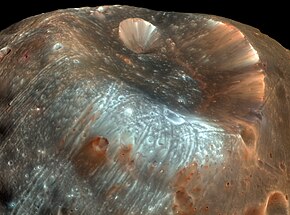 A false-color image of Limtoc within the Stickney crater, as seen by the Mars Reconnaissance Orbiter on 23 March 2008 A false-color image of Limtoc within the Stickney crater, as seen by the Mars Reconnaissance Orbiter on 23 March 2008 | |
| Feature type | Impact crater |
|---|---|
| Coordinates | 11°00′S 54°00′W / 11.00°S 54.00°W / -11.00; -54.00 |
| Diameter | 2 km |
| Eponym | Character from Gulliver's Travels |
Limtoc is an impact crater on the surface of Mars's moon Phobos. The crater, the diameter of which is 2 kilometers, is located within the larger and better-known Stickney crater. Limtoc was officially named by the International Astronomical Union on 29 November 2006, after a character from Jonathan Swift’s 1726 satirical novel Gulliver's Travels.
Limtoc is estimated to have formed within the last 109 million years, making it one of the youngest features on Phobos. When the Limtoc impactor collided with Phobos, it created a significant amount of ejecta which was sent towards the northern edge of Stickney, where it collided with that crater's rim. Ejecta sent towards the southern edge was largely catapulted out of Stickney. This ejecta partially contributed to the formation of the blue spectral coloration seen on the south-western edge of the Stickney crater, along with the ejecta from Stickney itself.
References
- ^ "Limtoc". Gazetteer of Planetary Nomenclature. USGS Astrogeology Research Program. (Center Latitude: –11.00°, Center Longitude: 54.00°; Planetographic, +West)
- ^ Kikuchi, Hiroshi (15 January 2021). "Simulating re-impacts from craters at the deepest location of Phobos to generate its blue spectral units". Icarus. 354. Elsevier: 113997. Bibcode:2021Icar..35413997K. doi:10.1016/j.icarus.2020.113997. S2CID 224926793. Retrieved 5 August 2022.
- Kikuchi, Hiroshi (2018). "Ejecta Emplacements of Limtoc Impact on Phobos" (PDF). 49th Lunar and Planetary Science Conference (2083). Lunar and Planetary Institute & Johnson Space Center: 2. Bibcode:2018LPI....49.1898K. Retrieved 30 August 2022.
This article about geology, geography or other features of the planet Mars or its moons is a stub. You can help Misplaced Pages by expanding it. |